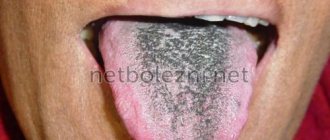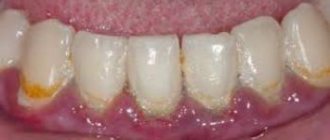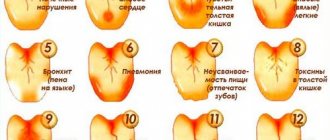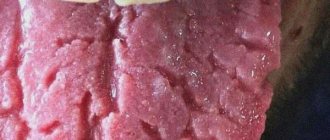A healthy child's tongue has a soft pink tint , but sometimes a dark gray or black coating appears on the surface of the baby's taste organ.
A change in the color of a child's tongue makes parents seriously worried.
There is no need to panic right away - black coating on the tongue in children is not always pathological .
What kind of coating on the tongue indicates health problems?
If there is a thickening of the plaque, a change in its color and the appearance of an unpleasant odor from the mouth , this is already the result of the activity of bacteria and fungi.
Of course, the body is not a sterile substance and microorganisms are always present in it, but the immunity of a healthy child controls their numbers. When immunity decreases or any disease occurs, there is a significant increase in pathogenic bacteria and fungi, which is accompanied by the formation of plaque on the child’s tongue.
Preventive measures
Black plaque is a signal that indicates the development of some disease in the body. To prevent its occurrence, you should follow the rules of oral hygiene, eat right, and ensure that you have a balanced sleep/rest schedule.
If you do not pay attention to the black coating covering the tongue and do not begin timely treatment of the disease that provoked its occurrence, the underlying disease may become chronic.
With timely treatment of the underlying disease, the black coating disappears from the surface of the tongue very quickly. It disappears completely after the disease that caused its formation is cured.
Causes of plaque on the tongue
There are many reasons why various plaques may appear on the tongue: from the banal consumption of foods that can change the color of the tongue, to serious health problems that require immediate medical attention.
Read also: Computer anesthesia STA – dentistry WITHOUT PAIN!
The very first thing you need to do when you discover strange coatings on a child’s tongue is to remember what the baby ate in the last 24 hours. Very often, sweet carbonated drinks, caramels or other sweets contain active dyes that can give the oral mucosa the most exotic shades: crimson, purple, green, orange and others. Even natural berries and fruits can radically change the color of the tongue. Therefore, there is no need to panic right away. You should ask the child to brush his teeth and tongue, and then evaluate their condition and color. If the plaque has not changed or has reappeared without connection with food intake, then this is a reason to urgently visit your pediatrician.
The most common causes of a black tongue
- Taking iron supplements (sorbifer, ferronal, etc.) in the form of syrups. These medications can be prescribed to children with iron deficiency anemia. After completing the course of treatment, it will again acquire normal color;
- Intestinal diseases. These include colitis, enteritis, dysbacteriosis. With these pathologies, not the whole thing is stained, but only its root.
- Diseases of the stomach, liver, gall bladder and bile ducts;
- Candidal stomatitis. With this pathology, the dark color is accompanied by a dense coating of off-white color;
- Diseases for which the child is forced to take antibiotics for a long time. In this case, the child’s tongue does not turn black immediately, but several days after the start of antibacterial treatment.
The symptom is constant, and this should alert parents;
First, let's figure out what a black coating on the tongue means and why it appears. If a black coating appears on a child's tongue, you cannot ignore it. It may indicate problems with the functioning of the stomach.
- Usually the appearance of plaque indicates that the baby’s stomach is not yet ready to digest the food that was provided to him.
- Also in children, this symptom may indicate the presence of candidiasis and dysbacteriosis.
In the case when a person is absolutely healthy, his tongue should be soft pink. In the presence of various diseases, you can notice a whitish-yellow coating on the tongue. Few people pay attention to this kind of formation, but when a plaque forms, for example, black in color, then panic begins. People are concerned about the unusual color of the tongue (black, dark brown).
There is no need to panic in the presence of such a dark coating. Try to remember if you have consumed any of the foods that can color your tongue (blueberries, activated charcoal, chocolate, sweets with dyes). If you do not remember whether you have consumed any of these products, consult your doctor.
Black coating on the tongue often indicates the development of serious diseases of the digestive tract. The shade and density of plaque indicates the patient’s condition. If the plaque is too dark and dense, then the patient’s condition is very complex. Such plaque can form on the teeth and the inner surface of the cheeks.
Black plaque is a sign of the development of such disorders within the body:
- deterioration of the pancreas;
- acidosis;
- gallbladder diseases;
- Crohn's disease;
- angina;
- depressed adrenal function;
- microflora imbalance.
Black plaque should be classified as a symptom of a disease in the body rather than as an independent disease.
The main reason for the appearance of plaque on the tongue is the bacteria accumulated on it. Most often, the bulk of plaque accumulates at the root of the tongue. This happens due to the fact that this place is the least mobile, while the tip of the tongue has the opportunity to clean itself while eating, drinking or during a conversation.
If parents find a little white coating on their baby’s tongue after waking up, then there is no need to panic for this reason. Since this process is considered normal, the main thing is that the natural structure of the tongue is visible under the layer of plaque. However, if the structure of the plaque or its thickness has changed, you must visit a doctor.
Plaque on a baby's tongue may differ in color, and this depends primarily on the reasons that provoke its appearance. The most common is the formation of white plaque. However, as mentioned above, its appearance does not at all mean the manifestation of any disease. Another type of plaque that should not cause concern to parents is a uniform, whitish coating. It usually appears immediately after feeding with formula or milk.
But there are cases when the presence of a white coating on the tongue of an infant indicates health problems. Namely:
- Cases when plaque spreads to the cheeks and gums throughout the day and does not disappear.
- Quite often, a white coating forms against the background of respiratory diseases.
- When plaque completely covers the baby’s entire tongue and is accompanied by symptoms such as nausea, stomach pain and diarrhea.
Also, the color of the coating on the tongue may be yellow, and this manifestation clearly indicates that there is a problem in the body. For example, a yellow tongue indicates that the child has liver problems. When plaque is located on the lower part of the tongue, this may indicate a disease such as jaundice.
In the case when a child has problems with the lungs, his tongue may be covered with a coating with a greenish, brown or gray tint. Of course, we are accustomed to seeing such manifestations mainly in the adult part of the population, but such symptoms also occur in children.
If a baby suffers from an infectious disease, a number of infections can cause a red coating to appear on the tongue. Also, similar manifestations are observed when a small organism is attacked by toxic substances. When problems with the kidneys occur, the tongue may acquire a rich burgundy hue.
We invite you to read: The tongue feels like it’s been burned, the reason
A black coating on the tongue is also found in infants. As you yourself understand, it does not bode well, since this symptom occurs mainly in seriously ill people. In children, the formation of black plaque may indicate diseases such as damage to the digestive system, cholera, Crohn's disease, and also indicate severe dehydration. But it is worth noting that attentive parents are unlikely to suddenly develop symptoms of this kind. However, as they say, he who is aware is...
A little higher, we have already paid some attention to this issue. Let's now figure out what specific disease a white coating on the tongue may indicate. A white cheesy coating in a baby is the main sign of a disease such as candidiasis, or in common parlance – thrush. The diagnosis can be clarified if this symptom is accompanied by the following signs:
- the child behaves excessively capriciously and restlessly;
- the baby refuses to take the breast because it hurts to suck;
- The baby's gums, palate and inner surface of the cheeks are clearly inflamed.
Candidiasis is an inflammatory process caused by the yeast-like fungi Candida. It is worth clarifying that this type of mushroom is found in small quantities in any human body. However, a decrease in immunity leads to an imbalance of microflora, which provokes uncontrolled proliferation of fungi.
Parents of an infant suffering from thrush should be wary. Since this disease without appropriate treatment can become chronic, which in turn can provoke an allergic reaction.
As a treatment for thrush in infants, it is recommended to use a soda solution. To do this, wrap gauze around the index finger, which must be placed in the solution and thus gently wipe the mucous membrane of the baby’s mouth.
Often in infants, the coating on the tongue has a yellow tint. If this manifestation occurs during a hot period of time, then without the presence of other symptoms, this is considered normal. However, if the color begins to change (becomes brighter), and the thickness of the layer also changes (increases), this may be a sign of a disease of the digestive system.
For example, if the gallbladder does not work properly, a yellow coating usually appears on the tongue. However, such a symptom may also indicate severe intoxication of the body, which occurs against the background of prolonged and frequent constipation. In addition, a yellow coating can also indicate lesions in the liver.
If you notice that your child's tongue has turned yellow, take it to the doctor as soon as possible. It would also be a good idea to visit a gastroenterologist for the purpose of a comprehensive examination and establishing the exact cause of the disease. A nursing mother needs to monitor her own diet more closely.
Try to completely avoid eating foods and drinks that contain preservatives and dyes, and you should also limit your intake of fatty foods. But it is advisable to consume fruits and vegetables in large quantities, this also applies to all fermented milk products. The main thing is to ensure that the baby does not develop allergic reactions to any product.
In cases where the cause of a yellow tongue is an imbalance in the stomach and intestines, it is advisable for a nursing mother to adhere to a certain diet that her doctor recommends.
Parents should know that in the morning, even before the first feeding, they should examine the baby’s tongue. A healthy baby's tongue should normally be free of any inflammation or plaque and have a pale pink color. Please note that depending on the time of year, your baby may periodically develop a coating on the tongue.
But when a newborn develops a green coating on the tongue, you should not put off going to the doctor, since this sign does not bode well.
The presence of a green tongue in an infant primarily indicates problems with the large intestine. If duodenal pathology is observed, plaque is usually localized in the middle part of the tongue. If, together with a green coating, redness of the tip of the tongue is observed, then we can definitely say that there is a violation of the acidity of the stomach.
Also, a green tongue may indicate kidney problems. Of course, such a pathology in infants is quite rare, but it does occur. In the case when the problem is fungal in nature, plaque forms mainly in the central part of the tongue. By the way, you should know that green plaque often appears in children during treatment with antibiotics and drugs that can reduce the body’s protective functions.
In conclusion, it is worth noting that parents need to be more attentive to the health of their own children and, for preventive purposes, carry out routine dental examinations as often as possible. Therefore, even if you cannot avoid the disease, you will definitely detect it at an early stage.
White coating on the tongue
White plaque can be found in the oral cavity of a baby most often.
This phenomenon also happens normally when, after a night’s sleep, a thin white coating without an unpleasant odor is found on the tongue, disappearing after hygiene procedures and not causing any discomfort or unpleasant sensations.
The appearance of a dense whitish plaque, which is extremely difficult to remove from the surface of the tongue and does not disappear after brushing your teeth, may indicate problems with the gastrointestinal tract (gastritis, enteritis or dysbacteriosis). This phenomenon is often accompanied by bad breath. In addition, children may present complaints that may indicate gastrointestinal pathology:
- abdominal pain of various localizations;
- bloating;
- stool disorders;
- change in appetite
In order to get rid of such white plaque, it is necessary, first of all, to examine the digestive system and eliminate even the most minor disturbances in its functioning.
Read also: Drilling teeth? NO thanks, we use ICON!
In infants up to 2 months of life, thrush or oral candidiasis is a common occurrence in a nursing mother, especially after taking antibiotics or an error in diet. With this pathology, abundant cheesy white deposits appear on the tongue and cheeks, which are easily removed, and small ulcers are found underneath them. After starting treatment for thrush with antifungal agents and treating the oral cavity with antiseptic solutions, the tongue and other mucous membranes quickly cleanse and regain their previous appearance.
What to do with all this
The most important thing that doctors (including Dr. Komarovsky) advise in such a situation is not to panic and try to treat the child with traditional methods or advice from the Internet. In any case, you should visit your pediatrician for an examination and possible further examination. This is especially true if the child complains of weakness and high temperature.
- The effect of food coloring . It is necessary to temporarily remove all coloring foods from the baby’s diet and everything will go away on its own and without a trace. To speed up this process, you can thoroughly clean the surface of the tongue with a soft toothbrush and continue to monitor the quality of your child’s oral hygiene.
- Plaque of fungal origin . You should not try to remove it. Treatment in such cases will consist of taking antifungal drugs in combination with treating the oral cavity with antiseptic solutions.
- Pathology of the digestive system . Elimination of the root cause leads to the rapid disappearance of any manifestations of black tongue. In the treatment of dysbiosis, eubiotic preparations (Linnex, Lacidofil, Bifidumbacterin and others) are good helpers, as well as following a gentle but rational diet.
- Hypovitaminosis . They are well corrected with complex vitamin preparations, with treatment with which all symptoms go away very quickly.
- Black hairy tongue . In this case, there is no specific therapy. This phenomenon most often goes away on its own. It is necessary to apply only preventive measures and treat the child’s oral cavity with antiseptic solutions.
Despite the fact that most often the causes of a black tongue in a child do not threaten his health, a visit to the pediatrician’s office should not be ignored. Only a specialist will help determine why such a problem appeared and how quickly it can be solved.
Gray coating on the tongue
A gray coating on the tongue can be a sign of some infectious diseases.
For example, with scarlet fever, on the very first day the mucous membranes become covered with a dirty gray coating, which, starting from the tip of the tongue, gradually disappears and reveals a “raspberry tongue” - enlarged papillae on a bright red background, which is very reminiscent of raspberries.
With diphtheria, gray filmy deposits can be found on the root of the tongue, which are difficult to separate. Such plaques spread to the mucous membranes of the throat, palatine arches and are accompanied by coughing and attacks of suffocation.
Treatment of such infectious diseases is carried out only in a hospital setting. After healing, all plaque on the tongue disappears.
Dehydration in a child can also lead to the formation of a gray coating on the surface of the tongue. At the same time, the mucous membranes look dry and dull. Replenishing the required volume of fluid quickly eliminates this symptom.
Diagnosis of the symptom
After discovering a black coating on top of the tongue, there is no need to guess about its nature; this concern should be left to specialists. Doctors, after conducting a series of tests and studies, will accurately diagnose what triggered the occurrence of such an unusual plaque. The tongue is considered an indicator of human health; a pathological coating indicates the development of complex diseases. When you visit a doctor, you will have to undergo an initial examination, during which the specialist will pay attention to:
- organ mobility;
- its relief;
- zonality of the raid;
- plaque shade;
- the presence of neoplasms (acne, ulcers).
- Blood test (general). Helps determine the condition of the liver. These tests are prescribed when the doctor suspects inflammatory processes within the body.
- . It is taken from the mucous membrane of the tongue. Checking the flora is necessary to determine its sensitivity to various antibiotics.
- Fibrogastroduodenoscopy. This type of examination is prescribed to a patient if there is a suspicion of an ulcer in the stomach.
- Coprogram. It helps detect inflammation in the intestines.
- Ultrasound examination of the abdominal cavity in the case when the doctor suspects liver pathology.
What to do if you discover that my tongue is covered with a black coating is described below.
Yellow coating on the tongue
A dense yellow coating on the tongue indicates pathology of the liver or biliary tract.
Often in children, diseases of the biliary system occur without a clear clinical picture, and the presence of bile stagnation can only be suspected by a change in the color of deposits on the mucous membranes of the oral cavity.
If a child has a yellow coating on the tongue , it is necessary to urgently consult a doctor and have an examination of the internal organs and the biochemical composition of the blood.
Read also: Medication sleep - WHAT? For what? HOW?
How is diagnosis carried out?
The doctor begins the diagnosis with a visual examination of the patient , assesses the appearance of the tongue and the nature of the deposits, and interviews the child and mother for complaints and associated symptoms.
Next, the doctor prescribes tests and diagnostic procedures:
- clinical blood test;
- Analysis of urine;
- blood chemistry;
- culture of microflora from the oral and nasal cavity;
- stool occult blood test;
- Ultrasound of the digestive organs.
If necessary, to clarify the diagnosis, the doctor can give a referral for gastroscopy and colonoscopy .
For your information! A specialist can prescribe all diagnostic procedures in a complex, or several of them separately.
If necessary, the pediatrician gives a referral to see specialists: dentist, otolaryngologist, gastroenterologist, infectious disease specialist.
Green coating on the tongue
The appearance of a green coating on the mucous membrane of the tongue often frightens parents, especially if it is found in a newborn or infant.
The most common cause of this phenomenon is candidiasis - a fungal infection of the oral cavity that occurs due to imperfect immune defense in the body of a 1-year-old baby or while taking strong antibacterial drugs.
This plaque has varying color intensities and can spread to other parts of the oral cavity, found on the cheeks, palate and lips. After removing it, you can see the red surface of the tongue with small blisters or ulcers, which cause discomfort to the child.
You should start treating green plaque only after consulting a doctor. Therapeutic measures will consist of taking special drugs with antifungal action and local antiseptics to treat thrush and prevent bacterial complications.
Read also: How bite affects posture and spinal health
How to get rid of this symptom
Therapy for such an unusual phenomenon as black plaque should be prescribed by a doctor after a detailed diagnosis. First of all, it is necessary to eliminate the main factors that caused this plaque.
Having discovered a darkening of the coating of the tongue, you should perform hygiene procedures more carefully. You need to clean your teeth, tongue, and gums with a brush.
Knowing why there is a black coating on the tongue, let’s try to get rid of it using folk methods.
Folk remedies can be used as a supplement to doctor-prescribed treatment. The most common options for eliminating black plaque:
- Drink tea made from varying amounts of oregano, linden blossom, plantain, and yarrow.
- Rinse your mouth with an infusion made from oak bark.
- Take an infusion made from flax seeds. Drink it in the morning before meals.
- Rinse your mouth with an infusion made from mint, sage, chamomile, and strawberry (leaves).
Brown coating on the tongue
A brown tongue in a child is not such a rare occurrence. There can be many reasons for this:
- Severe diseases of the digestive system , accompanied by inflammatory changes, stagnation of bile in the bile ducts, and disruption of the digestive processes.
- Constant dehydration of the child's body due to high ambient temperatures or insufficient fluid intake.
- Insufficient intake of B
- Taking certain medications : antibiotics, antiseptic solutions, concentrated herbal decoctions.
It is very difficult to establish the exact root cause of the appearance of such a dark plaque. This can only be done by an experienced doctor, who, after additional examinations, will be able to prescribe the optimal treatment.
Black coating on the tongue
The presence of a black coating on a child’s tongue looks quite scary, and there may be several reasons for this phenomenon:
Bacterial sore throat is often accompanied by the appearance of dark plaques on the mucous membranes, even black. In this case, the child will have signs of inflammation in the tonsils: red throat, high fever, pain when swallowing, weakness.
Hidden forms of diabetes mellitus, which lead to persistent disruption of the acid-base balance in the body. Excess acid or acidosis will cause darkening of the tongue.
Taking some antibiotics causes the growth of pathogenic microflora in the mouth, which causes the mucous membranes to become permanently stained black.
Treatment of such plaque will consist of eliminating the causes that caused its appearance. After a sore throat is treated, medications are stopped, or diabetes is identified and compensated for, this symptom will most likely go away on its own.
Physiological features
It happens that a dark coating appears in the middle and basal part of the tongue, forming a triangle or oval in the direction of the pharynx. This occurs as a result of multiple growth of the papillae of the tongue. Their keratinization is similar to villi; they are dark in color. This condition is rare and is called a hairy or villous tongue.
If the child is feeling normal, and there are no complaints of discomfort or dryness, there is no need to focus on this. The cause of this phenomenon often cannot be determined, and restoration of the normal appearance of the tongue occurs in children on their own, without unnecessary treatment, within a couple of weeks.
It is worth remembering that in case of any deviation from the norm, it is still worth visiting a doctor, getting a consultation and drawing up an observation and treatment plan. Do not resort to self-medication and do not try to independently look for the causes of black tongue in children. Only a specialist (possibly a combination of a pediatrician, a gastroenterologist, and a dentist) can determine why a child has a dark coating on the tongue, help cope with the problem and avoid its recurrence.
Maintain hygiene, adhere to a proper diet, avoid bad habits, undergo routine examinations with doctors - this is the main thing in maintaining the health of you and your children. Be healthy – and your tongue will thank you!
The tongue is, unfortunately, a part of the body that people very rarely pay attention to. Even in the process of admiring in the mirror, we examine our mouth, nose, eyes, and hairstyle more. If people knew that they could determine the presence of various diseases by the condition of their oral cavity, they would examine it more often.
The tongue has long been considered an indicator of health for the reason that it was on it that the first symptoms of an emerging disease appeared. So, let's learn about the treatment and causes of black plaque on the tongue in children, adults, and women during pregnancy, look at photos of patients and discuss ways to solve the problem.
Blue coating on the tongue
A blue tongue is a sign of blood stagnation.
Very often, various diseases of the cardiovascular (congenital heart defects, arrhythmias, heart failure) and nervous system (hemorrhages, cysts, epilepsy) lead to the fact that blood flows through the tissues more slowly than it should - cyanosis or cyanosis appears on the limbs, lips and language. Therefore, if you notice such a symptom in your child, you should urgently contact your doctor for advice.
Read also: Now the beauty and health of your child is completely in your hands
How to clean your tongue
There are 3 ways - using a teaspoon, a scraper brush, or brushing with a soft toothbrush. You can even brush with a little or no paste, but don't just brush with paste without a brush, that's harmful. Cleaning your tongue morning and evening is just as important as brushing your teeth. Why? Because more germs always collect on the surface of your tongue than on all your teeth.
Scraper - its use is simple, easy and pleasant, it is plastic, does not damage the mucous membrane, is sold almost everywhere, in any pharmacy, requires changing every 6 months. There is always a teaspoon at hand, but it is less effective and convenient to use; it is better to wrap it in gauze. Recently, a special scraper-brush has been often used; it has a semicircular shape, soft bristles, is flat, and is quite effective. A soft toothbrush is often used.
Some people use improvised objects to clean their tongue, even their fingers: wrap three fingers in gauze and clean the tongue with massaging movements. Some people use sucking vegetable oil for 10-15 minutes and then spitting it into the toilet. At one time this method was very popular. The movements are longitudinal, from the root to the tip of the tongue, soft, massaging and slightly scraping; cleaning occurs sequentially, in zones, just like teeth.
There are special gels for the tongue; they are applied after brushing, kept in the mouth for 1-2 minutes, then rinsed thoroughly. Recently, in the USA and Europe, almost everyone has an irrigator - a miniturbine device that creates a jet pressure of liquid and perfectly cleans all interdental spaces, the space under dentures, the tongue, provides micro-hydromassage of the entire oral cavity, and is very easy to use. Cleaning your tongue cannot be neglected.
Prevention
In order to prevent the appearance of plaque on a child’s tongue, there are a number of preventive measures that many experts focus on:
- The room in which the child lives should always be clean, well ventilated and humidified.
- You should not prescribe antibiotics to your child yourself. The use of such medications must be strictly justified.
- It is necessary to closely monitor the baby's health. If the slightest symptoms appear that indicate a possible disease from the internal organs, you should urgently seek medical help.
- Limit your child's consumption of sweets containing synthetic coloring pigments: sweet carbonated drinks, candies, chewing gum. This will not only prevent the appearance of active staining of the tongue, but will also preserve the health of delicate children's teeth.
If plaque does appear on the tongue, there is no need to try to remove or treat it yourself. Consult your doctor about the possible causes of this phenomenon and the necessary treatment for it.
Posted in For parents by biglamed
Nutritional reasons
The mucous surface of the tongue tends to become stained as a result of exposure to food dyes (synthetic or natural). In this situation, a child’s black tongue is an absolutely safe phenomenon. It is necessary to temporarily exclude from the children's diet foods and drinks that can give the tongue a dark color.
These include: various berries (blackberries, blueberries, currants, prunes, mulberries, chokeberries), juices and compotes based on them, all kinds of candies, chewing gum, candies, dark-colored drinks (including black tea, coffee). Then regular oral cleaning will restore your tongue to a healthy appearance.
Careful oral care is as follows. After each meal, you should rinse your mouth - this will remove food debris and reduce the growth of bacteria. You also need to teach your child to use a special tongue scraper; a regular toothbrush can replace this tool.
In infants, if complementary foods are introduced prematurely, a dark coating on the tongue may also appear, which signals that the baby's stomach is not ready for food other than mother's milk. In this case, it is worth temporarily postponing getting to know new products or changing your approach to the nutrition system.









